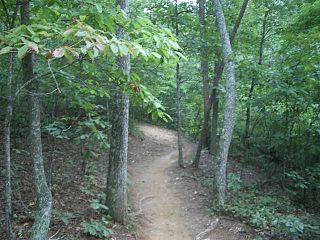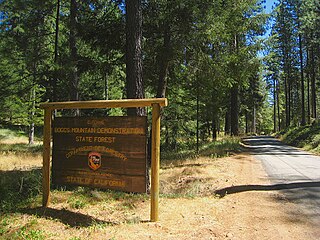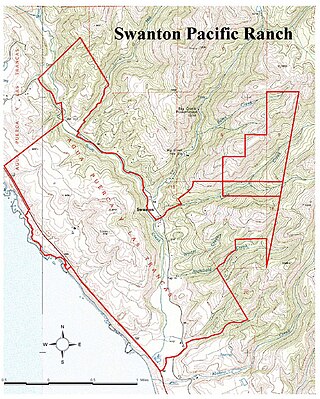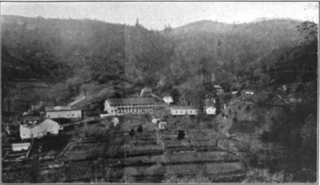
The Forest of Nisene Marks State Park is a state park of California, United States, protecting a secondary forest in the watershed of Aptos Creek and Soquel Creek within the Santa Cruz Mountains. It is located outside Aptos, California, and contains over 40 miles (64 km) of hiking trails and fire roads through 10,223 acres (4,137 ha) of variable terrain.

Pisgah National Forest is a National Forest in the Appalachian Mountains of western North Carolina. It is administered by the United States Forest Service, part of the United States Department of Agriculture. The Pisgah National Forest is completely contained within the state of North Carolina. The forest is managed together with the other three North Carolina National Forests from common headquarters in Asheville, North Carolina. There are local ranger district offices located in Pisgah Forest, Mars Hill, and Nebo.

St. Croix State Park is a state park in Pine County, Minnesota, USA. The park follows the shore of the St. Croix River for 21 miles (34 km) and contains the last 7 miles (11 km) of the Kettle River. At 33,895 acres (13,717 ha) it is the largest Minnesota state park. It was developed as a Recreational Demonstration Area in the 1930s, and is one of the finest surviving properties of this type in the nation. 164 structures built by the Civilian Conservation Corps and the Works Progress Administration survive, the largest collection of New Deal projects in Minnesota. As a historic district they were listed on the National Register of Historic Places and proclaimed a National Historic Landmark in 1997.

The Noyo River is a river on the north coast of California in Mendocino County. The river's headwaters are in the steep Mendocino Range, but downstream the river flows through gently sloping marine terraces before draining into the Pacific Ocean. The 113 square miles (290 km2) watershed extends east to the small city of Willits and the river's mouth is at Noyo Harbor in Fort Bragg, which uses the river for drinking water; it is neighbored on the south by Hare Creek and the Big River, on the east by the South Fork Eel River, and on the north by Ten Mile River, named for its distance from the Noyo River. The average annual rainfall is between 40 inches (1,000 mm) and 65 inches (1,700 mm).

Singletrack describes a type of mountain biking trail that is approximately the width of the bike. It contrasts with double-track or fire road which is wide enough for four-wheeled off-road vehicles. It is often smooth and flowing, but may also feature technical rocky sections, go over tree roots, and include berms, banked turns, switch-backs, hills, drops, jumps, and so forth. Singletrack which descends significantly, and in the most downward direction, is said to be following the fall line.

Jackson Demonstration State Forest is a public forest in Mendocino County, California managed by the California Department of Forestry and Fire Protection. It is the largest demonstration forest operated by the State of California. The forest land, located along California State Highway 20 between Willits and the coastal city of Fort Bragg, was formerly owned by Caspar Lumber Company. The forest holds sacred value as an ancestral home and ceremonial site for the Coyote Valley Band of Pomo Indians.

According to the California Protected Areas Database (CPAD), in the state of California, United States, there are over 14,000 inventoried protected areas administered by public agencies and non-profits. In addition, there are private conservation areas and other easements. They include almost one-third of California's scenic coastline, including coastal wetlands, estuaries, beaches, and dune systems. The California State Parks system alone has 270 units and covers 1.3 million acres (5,300 km2), with over 280 miles (450 km) of coastline, 625 miles (1,006 km) of lake and river frontage, nearly 18,000 campsites, and 3,000 miles (5,000 km) of hiking, biking, and equestrian trails.

Boggs Mountain Demonstration State Forest is a state forest in Lake County, California that covers the northwest of Boggs Mountain. It was founded in 1949, and came into operation in 1950 when most of the site had been clear cut. The purpose was to demonstrate good practices in restoring and managing a forest. The state forest was open for recreational use, including camping, hiking, mountain biking etc. The 2015 Valley Fire destroyed 80% of the trees. The state forest as of 2021 was replanting saplings.

Swanton Pacific Ranch is a 3,200-acre (1,300 ha) ranch in Santa Cruz County, California, outside the town of Davenport. The ranch is owned and operated by California Polytechnic State University for educational and research in sustainable agriculture. The ranch encompasses rangeland, livestock, and forestry operations for the College of Agriculture, Food and Environmental Sciences, comprises a significant part of the community of Swanton, and includes the lower Scott Creek watershed.

Santiam State Forest is one of six state forests managed by the Oregon Department of Forestry. The forest is located approximately 25 miles (40 km) southeast of Salem, Oregon, and includes 47,871 acres (193.73 km2) on the western slope of the Cascade Mountains in three Oregon counties: Clackamas, Linn, and Marion. It is bounded on the east by the Willamette National Forest and Mount Hood National Forest. Silver Falls State Park is located west of the forest. The rest of the land surrounding the forest belongs to the Bureau of Land Management or is privately owned. The forest is managed as part of the Department of Forestry's North Cascade District.

Savage River State Forest is located in the north and northeastern part of Garrett County, in the U.S. state of Maryland. The state forest has many waterways, including Savage River Reservoir, which was built in 1952 by the U.S. Army. The dam was built as an emergency water supply for Washington, D.C. Savage River State Forest is known for its hunting, fishing, camping, and hiking trails.
Reynolds Wayside Campground is a state park in Mendocino County, California, United States. The site, which contained a redwood grove, was purchased by Frank W. Reynolds and his wife in 1928 and converted into a resort known as Reynolds Redwood Flat in 1930. After Mr. Reynolds died in 1962, the site was leased until the California state government purchased it in 1966 as a memorial to Reynolds and to protect it from logging. Under state management, 50 campsites were constructed at the site, which was renamed to Reynolds State Recreation Area before taking its present name. In 1976, the campsites were removed and the property was deemed surplus the next year. Much of the site's land was exchanged with a timber company for territory at Sinkyone Wilderness State Park in 1984. As of May 2021, Reynolds Wayside Campground contains 38 acres (15 ha) of land, including area for hiking and access to the Eel River.

Rancho Soquel was a 1,668-acre (6.75 km2) Mexican land grant in present-day Santa Cruz County, California given in 1833 by Governor José Figueroa to María Martina Castro y Amador. In 1844, Martina Castro was granted by Governor José Figueroa a further 32,702-acre (132.34 km2) grant known as the Soquel Augmentation. The Rancho Soquel grant along Monterey Bay includes present-day Soquel and Capitola. Rancho Aptos of her brother Rafael Castro formed the south boundary of the grant. The much-larger Soquel Augmentation grant lay inland from both of these, and comprised mainly mountain watershed land.

The Galbreath Wildlands Preserve is a 3,670-acre (14.9 km2) nature reserve in Mendocino County, California, United States, established in 2004 in honor of Fred Burckhalter Galbreath (1901-2000). The preserve, a former sheep ranch, is located in the Outer Coast Range 17 miles (27 km) from the coast, near Yorkville. The Preserve features woodland, forest and grassland communities that lie at the edge of coastal fog influence. Lands are in the upper Rancheria sub-basin of the Navarro Watershed and contain 1st - 5th order streams. The Preserve's forests are primarily second-growth coniferous forest and hardwood.
San Vicente Redwoods is an emerging 8,500 acres (34 km2) mixed-use open space in Davenport, California. It is the largest privately owned parcel in Santa Cruz County, California, and one of the largest in California.

Aptos Creek is a southward flowing 9.5 miles (15.3 km) creek that begins on Santa Rosalia Mountain on the southwestern slope of the Santa Cruz Mountains in Santa Cruz County, California and enters Monterey Bay, at Seacliff State Beach in Aptos, California.

Mountain Home Demonstration State Forest (MHDSF) is a state forest located on Bear Creek Road (Tulare County Route 220), 28 km (17 mi) northeast of Springville in Tulare County, California. The protected land covers an area of 4,807 acres (19 km2) with an elevation range between 1,463 m (4,800 ft) and 2,377.5 m (7,800 ft). The forest is best known for its namesake giant sequoia grove, Mountain Home Grove, which is home to some of the largest giant sequoias in the world.

Boggs Mountain is a mountain the Mayacamas Mountains in Lake County, California. Part of the mountain holds the Boggs Mountain Demonstration State Forest. About 80% of the trees were burned in the September 2015 Valley Fire.
Soquel Creek is a southward flowing 16 miles (26 km) creek that begins in the Santa Cruz Mountains in Santa Cruz County, California and enters Monterey Bay at Capitola Beach in Capitola, California.

















